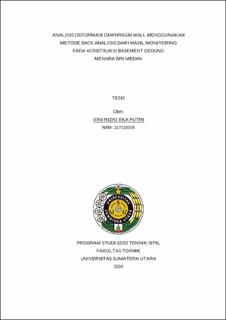| dc.contributor.advisor | Roesyanto | |
| dc.contributor.advisor | Hasibuan, Gina Cynthia Raphita | |
| dc.contributor.author | Putri, Vini Rizki Eka | |
| dc.date.accessioned | 2024-11-05T08:47:10Z | |
| dc.date.available | 2024-11-05T08:47:10Z | |
| dc.date.issued | 2024 | |
| dc.identifier.uri | https://repositori.usu.ac.id/handle/123456789/98600 | |
| dc.description.abstract | Deep excavation and installation of steel struts (temporary support) in basement construction will cause lateral deformation in the diaphrgm walls. To determine lateral deformation in deep excavation work, it is necessary to know the stages during excavation. The basement construction at the BRI Medan Tower is surrounded by office buildings. With soil dominated by sand, medium sand, clay silt and grevel, a retaining wall was built in the form of a diaphragm wall 17.50 meters deep with a wall thickness of 0.60 meters. Therefore, calculations are also needed regarding the stability of retaining walls in accordance with the requirements of SNI 8640:2017 concerning Geotechnical Design Requirements. The author will calculate the deformation value and safety factor value on the diaphragm wall using the Finite Element Method in PLAXIS 2D. Analytical calculations to calculate stability values against sliding, overturning and stability values against push-in failure using the Rankine method. The deformation results on PLAXIS 2D will be compared with the monitoring results in the field using the back analysis method through the results of inclinometer and settlement plate readings. The result of the lateral deformation of the diaphragm wall from the analysis using PLAXIS 2D modeling that has been carried out are 7.72 mm. And the safety factor for the stability of the diaphragm wall against shear is 2.54 (meets the requirements for SF shear > 1.5). Meanwhile, the safety factor against rolling is 3.59 (meets the requirements for rolling SF > 2). And the safe value for the stability of excavated soil against push-in failure is 1.84 (fulfilling SFpush-in requirements >1.5). The safety factor value for excavation work with PLAXIS 2D is 1.85. Apart from that, when deep excavation work is carried out, reinforcement is carried out by a temporary support (strut) on the diaphragm wall. So as to minimize the deformation that occurs. However, when a comparison was made between the deformation results in PLAXIS 2D and the monitoring results in the field. A discrepancy occurred caused by changes in parameters at deep excavation. | en_US |
| dc.language.iso | id | en_US |
| dc.publisher | Universitas Sumatera Utara | en_US |
| dc.subject | deformation | en_US |
| dc.subject | diaphragm wall | en_US |
| dc.subject | basement | en_US |
| dc.subject | PLAXIS 2D | en_US |
| dc.subject | back analysis method | en_US |
| dc.title | Analisis Deformasi Diaphragm Wall Menggunakan Metode Back Analysis dari Hasil Monitoring pada Konstruksi Basement Gedung Menara BRI Medan | en_US |
| dc.title.alternative | The Analysis of Deformation of Diaphragm Wall by Using Back Analysis Method from Monitoring Results in Building Basement Construction of the BRI Tower Medan | en_US |
| dc.type | Thesis | en_US |
| dc.identifier.nim | NIM217016006 | |
| dc.identifier.nidn | NIDN0029065102 | |
| dc.identifier.nidn | NIDN0010108906 | |
| dc.identifier.kodeprodi | KODEPRODI22101#Teknik Sipil | |
| dc.description.pages | 153 Pages | en_US |
| dc.description.type | Tesis Magister | en_US |
| dc.subject.sdgs | SDGs 9. Industry Innovation And Infrastructure | en_US |


